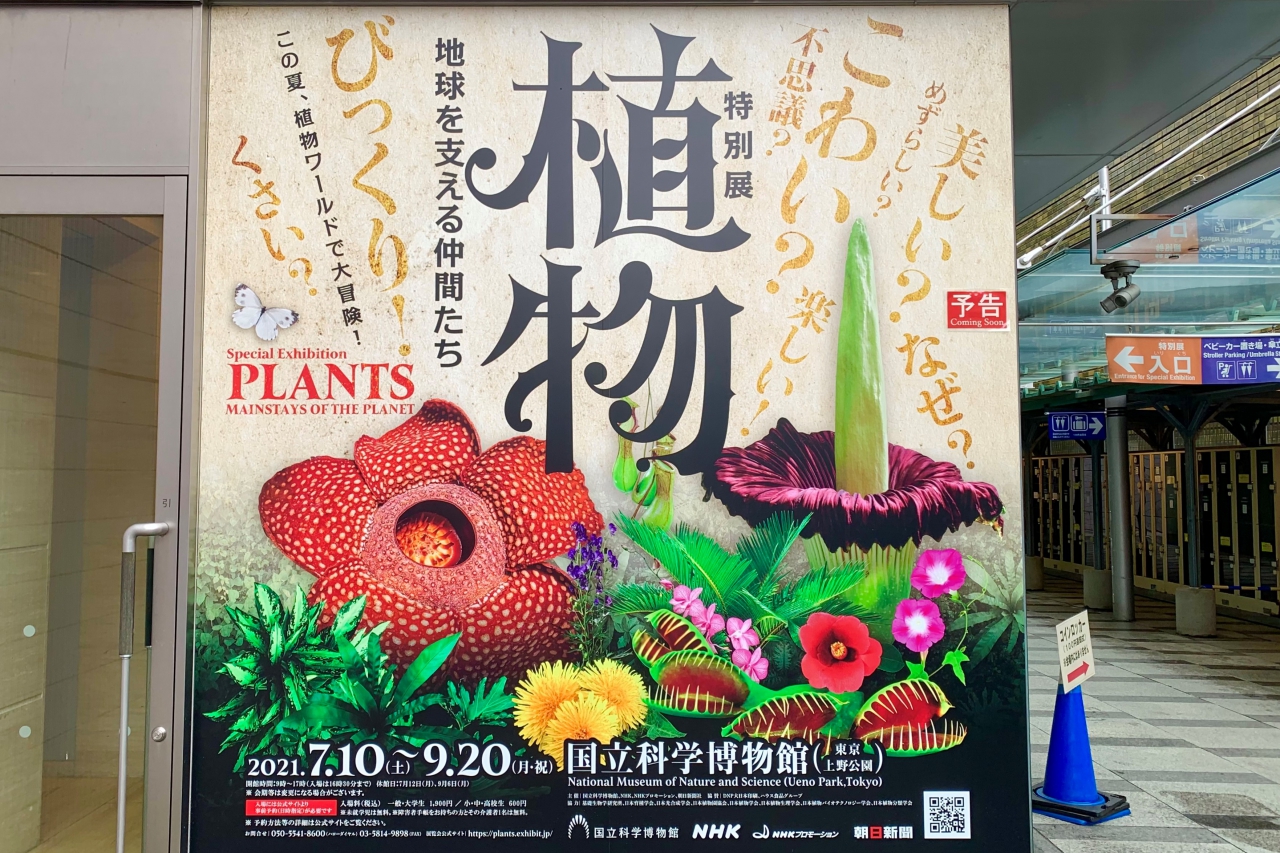
From Saturday, July 10th to Monday, September 20th, 2021, a special exhibition "Friends Supporting the Plant Earth" is being held at the National Science Museum in Ueno, Tokyo.
It's a plant, but it's active or ferocious, too big or too small. This exhibition is full of mysteries and surprises, where you can experience the unknown world of plants. We will report on the venue and highlights.
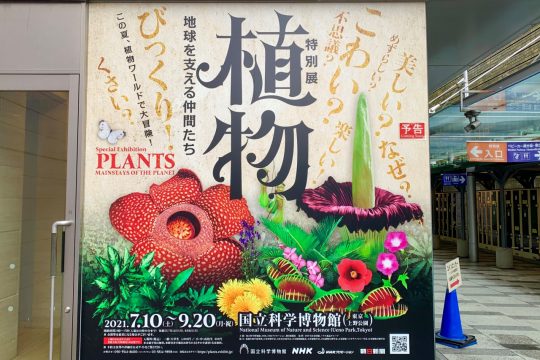
"Plants that support the earth" full of unique plants
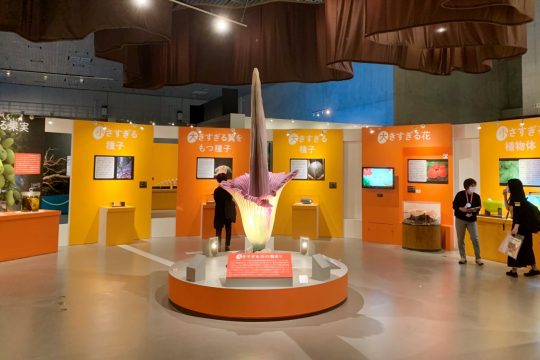
Exhibition scenery

Exhibition scenery

Exhibition scenery
Based on the latest scientific research results, this exhibition will be held all over the world from primitive to modern times from various viewpoints such as the way of life, living environment, shape and evolution of plants, which are indispensable for life on earth. This is a large-scale exhibition that introduces plants .
Not only can you see exhibits such as specimens, models, videos, and installations, but you can also comprehensively learn about the ecology of more than 200 types of plants while stimulating your sense of hearing and smell with music and scents.
Astonished by the non-standard scale!
One of the highlights of the exhibition, be on the watch visitors in the area entitled "○○○ too plant us", it would be the exhibition of the plant we too large.
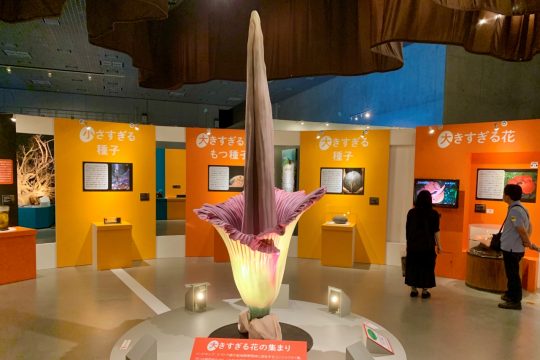
"Titan arum" full-scale model
The first thing that catches the eye is the full-scale model of the "Titan arum", which grows naturally in the lowland rainforest of Sumatra, Indonesia, and has the world's largest inflorescence (a collection of flowers). The height is 2.72m, which is a little in the fantasy area …! I was surprised that it reached 3.1m in the Guinness World Records.
It is a mysterious ecology that heats up to about 38 degrees when it blooms and emits steam, and at that time it seems to evaporate the odor to attract insects, but there was a booth in the venue where you can smell the reproduced odor. Please experience the intense stench that the author, who was careless, unexpectedly warped.

"Rafflesia" full-scale model Kyoto Botanical Gardens
In addition, the appearance of "Rafflesia", which is familiar as the largest flower in the world. The full-scale model on display is a type called "Rafflesia Arnoldi" distributed on Sumatra Island, with a diameter of 80 cm.
Most people think of red flowers when they hear "Rafflesia," but do you know what the leaves and stems are like? Actually, the members of the genus "Rafflesia" are parasites that parasitize the woody vines of the vine family and absorb nutrients, so only the flower part exists. The effronterie (?) That makes it famous as the best flower in the world from the standpoint of parasitism is interesting.
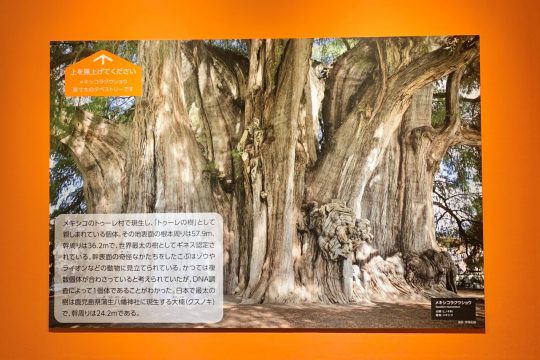
Photo of "Mexico Bald Cypress"
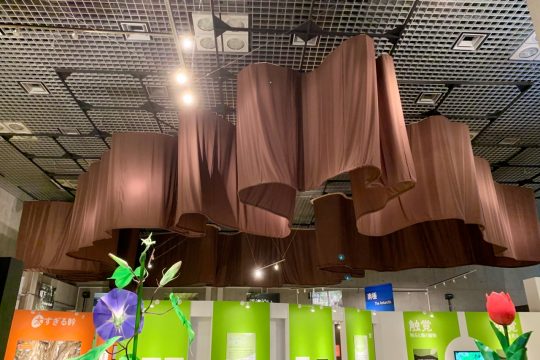
A tapestry that reproduces the scale around the trunk of "Mexico Bald Cypress"
Furthermore, the "Mexico cypress", which is the "tree of Toure" that exists in the village of Toure in Oaxaca, Mexico, has a root circumference of 57.9 m and a trunk circumference of 36.2 m, and is certified as the thickest tree in the world by the Guinness World Records. It is also a must-see to reproduce the hugeness around the trunk with a tapestry by making good use of the space on the ceiling of the venue. Please experience the scale feeling that is unbelievable and laughable.
In addition, many high-impact plant objects such as "Hanefukube Seed" with too large wings, "Jackfruit" with too large fruit, and "Jackfruit" with too large pine cones were exhibited.
From ancient fossils to genetically modified plants

Cladoxylons "Hironia Elegance (Leaf)" National Museum of Nature and Science

Lepidodendron "Lepidodendron acreatum (trunk surface)" Osaka Museum of Natural History
From the birth of plants to landing, the birth of forests, the birth and diversification of gymnosperms and flowers … In the area that introduces the history of the dynamic evolution of plants, a number of precious plant fossils are lined up.
Along with the restored illustrations, the world's first large-scale plant fossil "Cooksonia Balandy", fossils of cladoxylons, the first plant to make a large body over 10M, and the main composition of a huge wetland forest in the Carboniferous period The fossils of Lepidodendron, which became an element, tell us what the earth looked like long before the appearance of humans.
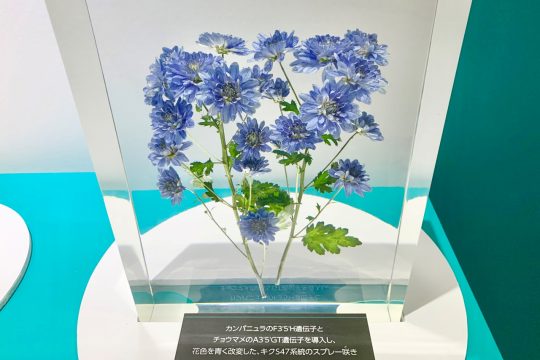
Resin specimen of "blue chrysanthemum" Agricultural Research Organization Collection
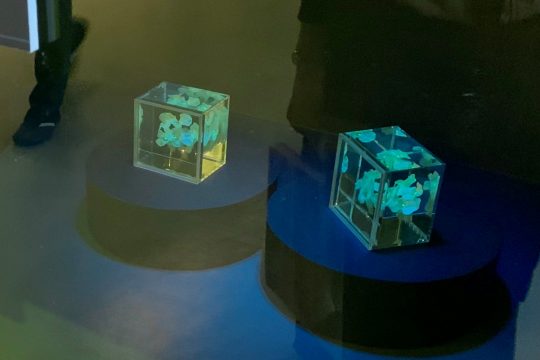
Resin specimen of "shining torenia" Implanta Innovations Co., Ltd.
On the other hand, it also covers modern plant circumstances such as "blue roses" and "blue chrysanthemums" that did not exist in nature before and were born by genetic recombination technology.
Looking at the beauty of the yellow-green fluorescence emitted by "shining torenia" created by introducing the gene of the fluorescent protein of marine plankton with the aim of imparting a new trait of "shining", this technology will be in the future. It makes me excited to see how it develops.
Really scary plants
Cunning carnivorous plants and ferocious fruits, which make people who have the image of "quiet" and "healing" for plants, also have a presence at the venue.
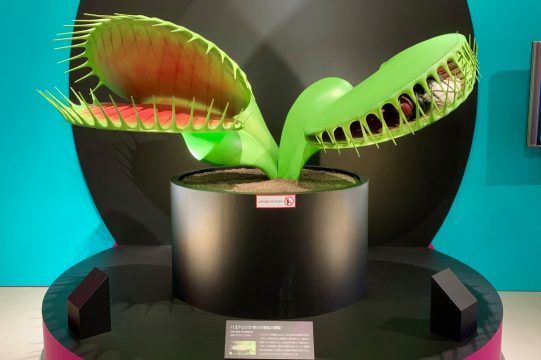
"Venus flytrap" (approx. 100x magnified model) In the leaf on the right side, you can see the trapped insects …
"Venus flytrap" that closes the leaves to prevent insects from escaping when the sensory hair is stimulated twice within 30 seconds, and "Drosera rotundifolia" that catches insects with sticky digestive juice and dissolves them to the core of the body in half a day Reproduces the dignity of its form, which is not limited to its properties, with a magnified model of about 100 times and about 200 times.
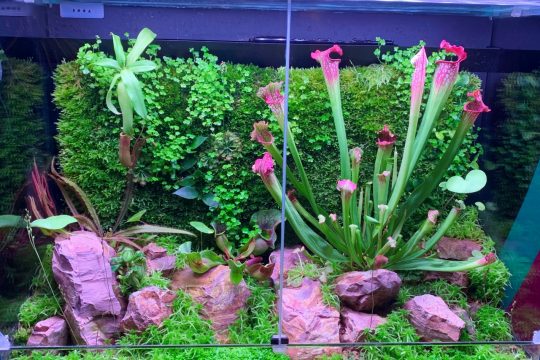
Aquarium containing 12 kinds of carnivorous plants such as "Drosera adelae"
In the aquarium exhibition next to it, many of them are packed like a diorama with carnivorous plants that look pretty at first glance alive. I can't help but imagine what would happen if I let go of insects in this lawless area.
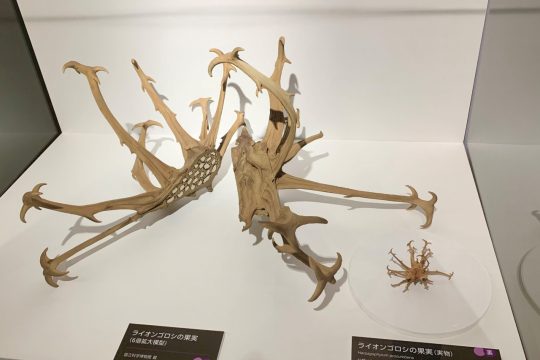
6x magnified model of "Rion Goroshi Fruit" (left) and real thing (right) National Museum of Nature and Science
A typical example of a "ferocious" plant that attaches to animals with hook-shaped tips and thorns called "kaeshi" and sprays fruits is a lion that has adhered to the mouth and has become unable to open its mouth and starved to death. There is also an actual exhibition of fruits such as "Lion Goroshi", which has an anecdote, and "Onibishi," which looks exactly like Makibishi, which is famous for its ninja tools.
It is also interesting that they all have a gap in common that the flowers themselves are very beautiful.
Fun entertainment elements too!
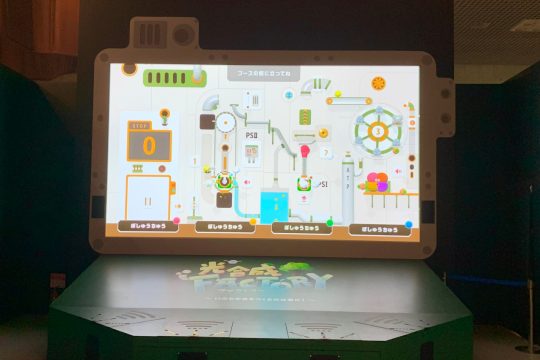
Installation exhibition "Photosynthesis FACTORY"
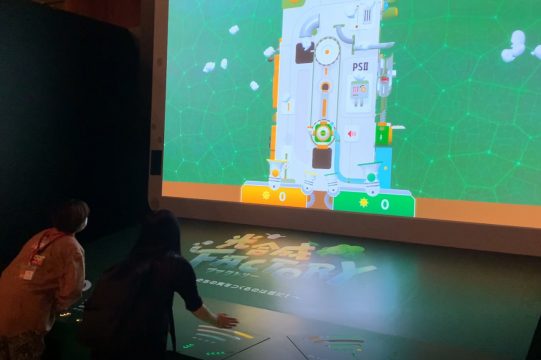
"Photosynthesis FACTORY" play
There is also a participatory installation exhibition in the venue that children can enjoy.
The browser game "Photosynthesis FACTORY" for smartphones that allows you to learn the mechanism of photosynthesis is that the player becomes the factory manager of the photosynthesis factory and clears three missions. At the venue, you can experience Mission 1 with your body with up to 4 players. (Click here for smartphone games ⇒ https://kougousei-factory.com )
How much can you collect (photons) under light energy while cooperating with other players? The operation is as simple as moving your arm, but when you try it, it naturally becomes like a competition with other players, so even adults alone can get excited.

The lyrics of "Flower Gene ABC" are also on display.
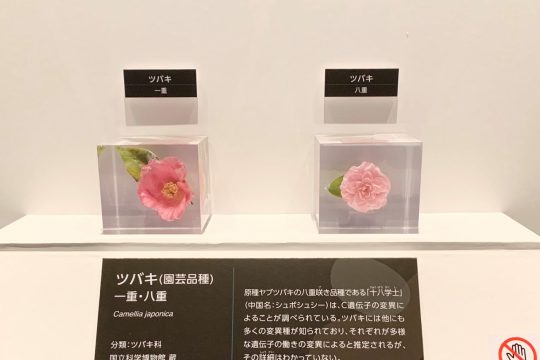
On the right is a resin specimen of "Camellia (cultivar) Yae" born from a mutation in the C gene of a flower. Collection of the National Science Museum.
Speaking of having fun learning, there are explanations about the three genes "A gene", "B gene", and "C gene" that the shape of the flower is determined by the combination in the venue, but it is related to "Flower gene ABC". The original song is playing. It's a song to learn the functions of the three genes, but the lyrics and melody may be a little strange.
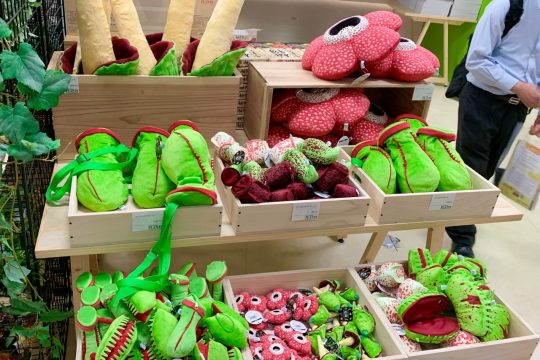
Special shop
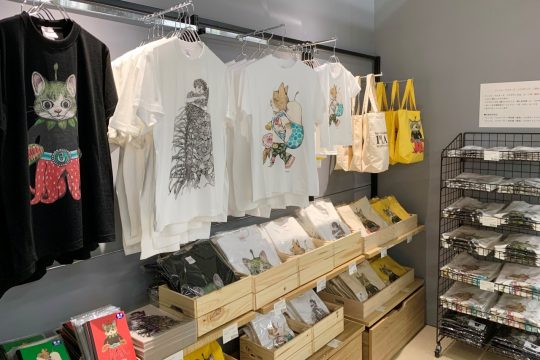
Special shop
In addition, at the special shop of this exhibition, original goods limited to the exhibition using designs drawn by 4 popular creators on the theme of "plants", including cushions and pouches of quirky plants such as "Rafflesia". , Collaboration products with the popular trading card game "Duel Masters" are on sale. If you want it, please come and visit us as soon as possible.
Outline of the special exhibition "Plant Exhibition Friends Supporting the Earth"
| Session | July 10th (Sat) -September 20th (Monday / holiday), 2021 * The session is subject to change. Please check the official website for the latest information. |
| Venue | National Science Museum |
| Opening hours | 9:00 to 17:00 (admission is until 16:30) |
| closing day | July 12th (Monday), September 6th (Monday) |
| Admission fee | General / university students: 1,900 yen (tax included) Elementary / middle / high school students: 600 yen (tax included) * Online advance reservation (date and time specified) is required. |
| Organizer | National Science Museum, NHK, NHK Promotion, Asahi Shimbun |
| Exhibition official website | https://plants.exhibit.jp |


